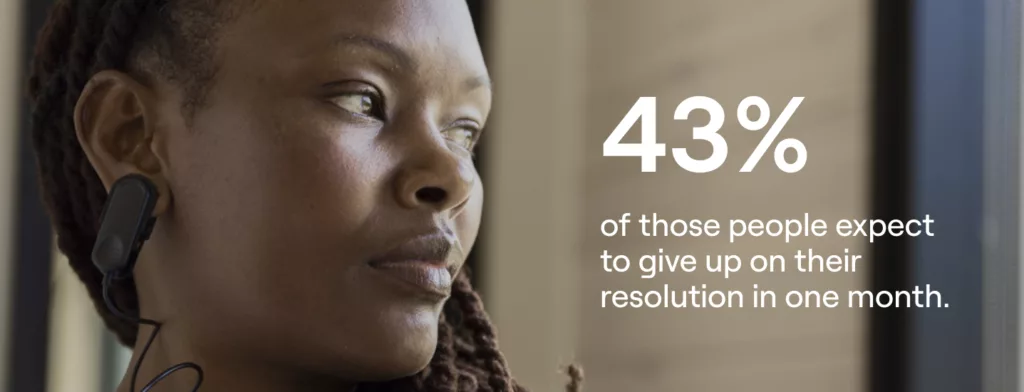 For a small portion of people, New Year’s resolutions can lead to positive change. For the rest of us — the vast majority — they’re a superhighway to crushing disappointment. Don’t worry. There are proven steps you can take for building new habits. But making a New Year’s resolution runs directly counter to a lot of what we know about the science of behavior change.
For a small portion of people, New Year’s resolutions can lead to positive change. For the rest of us — the vast majority — they’re a superhighway to crushing disappointment. Don’t worry. There are proven steps you can take for building new habits. But making a New Year’s resolution runs directly counter to a lot of what we know about the science of behavior change.
People know this. A full 43% of resolution makers expect to fail by the end of January. That’s pretty close to the real figure (36%). According to one study, 25% of New Year’s resolution-makers give up by January 7th. A separate report, which analyzed exercise and activity data on the fitness app Strava, dubbed January 19th “Quitting Day,” because the data pointed to that as the day with the most resolution quits. By the end of the year, 91% of New Year’s resolutions are nothing but unfulfilled self-promises.
Yet every year we’re pummeled with language about New Year’s resolutions and promises of “fast fixes” — 7-day makeovers, 30-day fitness fads. Unfortunately, these create two big thinking traps. Here’s what they are and how to avoid them, so you can make the changes you want — for good.

Trap #1, and how to avoid it
Pegging change to an arbitrary date is not how true motivation actually works. Even if this is the year for you to make a change, Jan. 1 has a one-in-365 chance of being the right day for you.
 Calendar dates and seasonal trends are external — they’re aligned with forces completely separate from your own needs and motivations. Successful resolution-makers exemplify something called self-determination. In simple terms, this theory explains the power of intrinsic motivation versus extrinsic motivation. Intrinsic motivation is rooted in who you are and who you want to be — it comes from within. Extrinsic motivation is, you guessed it, external — January 1, a prize, or someone asking you to make the change that they want you to make.
Calendar dates and seasonal trends are external — they’re aligned with forces completely separate from your own needs and motivations. Successful resolution-makers exemplify something called self-determination. In simple terms, this theory explains the power of intrinsic motivation versus extrinsic motivation. Intrinsic motivation is rooted in who you are and who you want to be — it comes from within. Extrinsic motivation is, you guessed it, external — January 1, a prize, or someone asking you to make the change that they want you to make.
For example, going to the gym because the world says you need a beach body is an example of responding to extrinsic motivation. (Marketers are telling you what to do.) It’s exhausting, because you’re constantly forcing yourself to do something, even though it’s not aligned with your internal wants and needs. That’s a losing proposition.
Fundamentally changing your relationship with exercise so that building fitness is something you truly want to do — that’s the magic. You don’t have to convince yourself to go to the gym, because you already want to go there — it aligns with how you want to live. That’s intrinsic motivation. Decide, deep down inside, what change you want to make and why — then take the steps to make the change. If the right time is January 1, great. If it’s March 27, all good. (We mention gyms because 95% of New Year’s resolutions are health- and fitness-related.)
 Trap #2, and how to avoid it
Trap #2, and how to avoid it
Despite all the promises from the self-help industry, habit building isn’t “fast.” We know from research that it generally takes more than two months of focused work to lock in a new habit. (Those 7-day makeovers come up about 90% short!).
Focused work doesn’t mean perfection. The 9% of people who actually succeed with their New Year’s resolutions aren’t better or smarter than the rest of us. But research shows that they set realistic yet specific expectations and forgive themselves when they slip up. Instead of getting derailed, they see the next day as a moment to reset and recommit. They focus on the process instead of the individual wins and losses.
Your checklist for change
So, change means finding real motivation and committing to the process. How to go about it? Here are some proven steps to get you started:
- Align the goal with your values or a broader sense of self. If you decide you want to read a book a week, why? How is that aligning with who you are or who you want to be?
- Write down a list of the good things accomplishing your goal will provide for you. Ifit’s reading books, the list could be increased knowledge about some interesting topics, less time on social media, the creative spark that comes from reading good fiction, etc.
- Now, visualize yourself completing the desired goal day after day. Allow yourself to feel the positive emotions you’d experience as a result of achieving your goal. This is called self-efficacy, and it increases your chances of success by increasing your belief in your ability to succeed.
- Remind yourself that you’re in control of your behaviors and the goals you set. Change should feel like a personal journey, not a response to societal pressure.
- Enlist a friend, loved one, or professional — like a therapist or coach — for support. Research shows that this sort of accountability improves people’s chances of building and maintaining new habits.
Regardless, we’d like to suggest that you resolve NOT to make a New Year’s resolution this January. Instead, achieve change by replacing short-term disappointment with a focus on the big picture. That’s something worth toasting in the new year!





